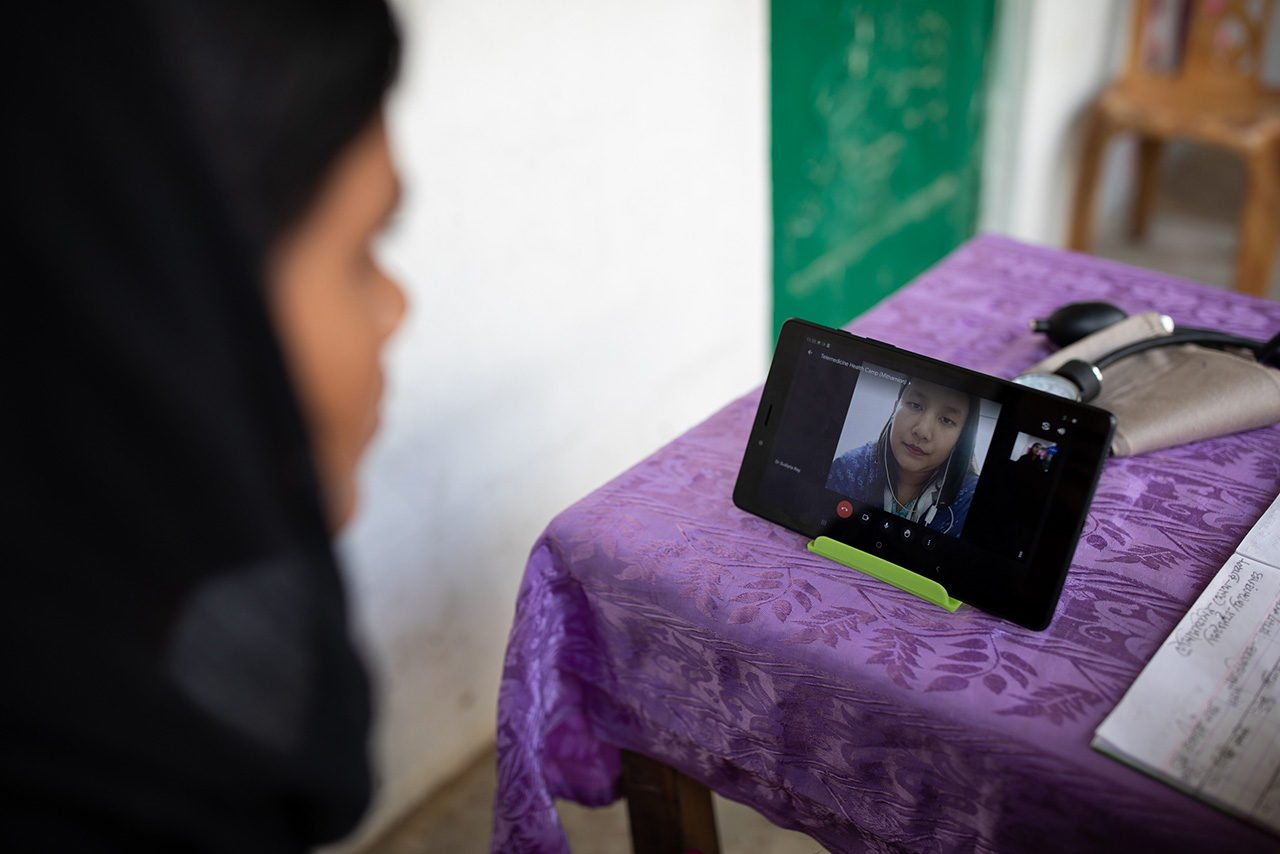Digital doctor: Bridging healthcare gaps in remote areas
Reading Time: 3 minutes
Accessing healthcare is almost always a challenge in remote areas. Telemedicine is a low-cost, time-efficient approach to overcoming this.
Popi Akhter’s village is shaped like a bowl. It remains submerged in water for half of the year. During those times, getting anywhere is a near-impossible task.
Ajmiriganj is located in the remote haor region – wetlands – in eastern Bangladesh. When 21-year-old Popi was pregnant with her first baby, she experienced complications and needed to consult a doctor urgently. The nearest hospital was 10 kilometres away, and the road was too broken and dangerous for her to make the journey.
A crisis was averted when her aunt, a member of a village development organisation, registered Popi for a virtual medical consultation, and she was able to speak to a doctor the next day.

Popi Akhter, who lives in the remote haor region of eastern Bangladesh, consulting a doctor about her health issues through a video call. Photo credit: Fahmida Hashin © BRAC 2022.
Like Popi, women living in hard-to-reach areas often face challenges in accessing basic healthcare services, primarily due to the remoteness, poor infrastructure and high costs. Only 6.8% of the women living in these areas seek antenatal care from mainstream service providers when they face a critical problem – the national average is 37%.
COVID-19 created even more reluctance for people in remote areas to visit healthcare facilities, due to movement restrictions and fear of infection. As a result, many women living in hard-to-reach areas in particular, remained untreated.
Ajmiriganj became the first place for BRAC to test out an idea: If people weren’t able to go to the doctors, was it possible to bring the doctors to them?
A telemedicine service was introduced in December of 2020, to digitally connect people living in the remote region with healthcare professionals.
How does it work?
The telemedicine ‘camp’ is located in a home or enclosed space within the haor, allowing women to access healthcare services without having to travel long distances. The camp is mobile, so it shifts locations as per the needs of the community.
Patients consult with doctors over a video call, supported by on-location paramedics. The service is provided free of cost and caters particularly to women, children and the elderly. The doctor at the other end is a general practitioner who advises on a wide variety of ailments including gynaecological and antenatal issues. Common complaints of patients include back pain, neck pain, fever, cough and other symptoms.

Women feel more comfortable sharing their health issues with a female doctor: Intna, Ajmiriganj, Habiganj Photo credit: Abdullah Al Kafi © BRAC, 2022
The camp is organised every other week and run by trained paramedics and health workers – who are all women from the same community they serve. Pre-registration is encouraged, and this is usually led by the members of the all-women village development organisations.
At the camp, the community health worker initially helps to organise patients, takes the vital signs and notes symptoms. The paramedic then helps patients to connect with a doctor online, writes the prescriptions and assists them in understanding the conversation.
Why the focus on women?
The approach is centred around women particularly because women face additional challenges in accessing healthcare compared to men, usually due to safety issues and social norms inhibiting their travels outside. Consultation in a private space with doctors and paramedics who are all women, creates a sense of comfort for the patients.
The members of the village development organisations – women people know and trust – endorse the service, encouraging patients to share their health information and motivating them to seek treatment.
Telemedicine is becoming popular. Since its launch, more than 4,900 women, including people with disabilities, have received healthcare support through BRAC’s telemedicine service, and the number of patients is rising.
“It was the first time I consulted a doctor via video call,” said Popi. “I was initially doubtful whether the doctor would understand my problem. But when the conversation started, my doubts went away. She listened to me and advised me to follow some rules during my pregnancy – I felt comfortable, and look forward to my next appointment”.

Women living in Itna are receiving healthcare services at their doorstep through telemedicine. Photo credit: Abdullah Al Kafi © BRAC, 2022
Telemedicine has proved to be an effective service for people in hard-to-reach areas, reducing the time and costs of travel. Research has shown that telemedicine services can reduce average costs of seeking treatment by 56% travel time by 94%, compared to existing conventional approaches.
BRAC’s telemedicine service has been piloted in six remote sub-districts of Habiganj, Sunamganj, Kishoreganj, Naogaon and Dinajpur. BRAC is slowly scaling it up in other areas with similar contexts.
BRAC’s Integrated Development programme works with 1.7 million people living in hard-to-reach areas, such as haor (wetlands), char (riverine islands) and plainland indigenous communities living in poverty to improve their socio-economic conditions by creating diverse livelihood opportunities and bringing basic services to their doorsteps. The programme provides its interventions through a one-stop community platform, village development organisation, run by women members selected from the community.
Roksana Hoque is a manager, Monitoring and Evaluation, at BRAC Integrated Development Programme
Sonali Chakma is Communications Specialist at BRAC Communications.





